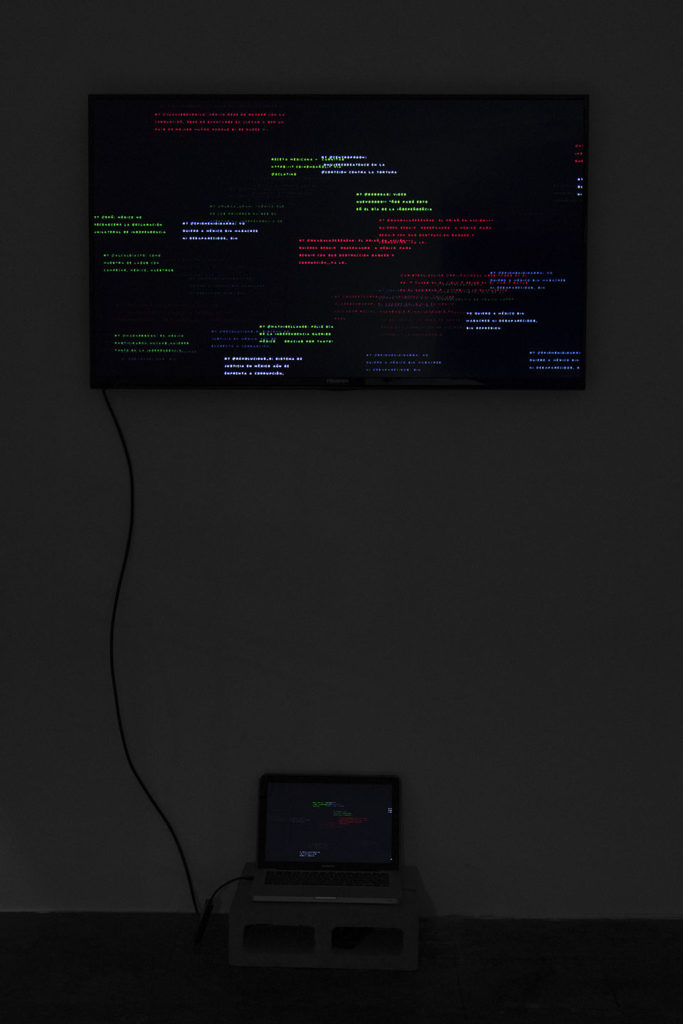ℌEXOℜℭℑSMOS – HIPERCORRUPCIÓN

(Live twitter data, Processing, 2017)
Exhibited at “La Confusion de las Lenguas”
Curated by Luis Alonso Sanchez
@ Deslave (Tijuana, México)

“The same old joke of the three men that walk into bar: el presidente de México, el president of the United States of America and the Prime Minister of Canada entran a una habitación para discutir el futuro del Norte. La conversación se realiza en inglés, but the mexican president doesn’t understand a thing, sure, he can barely make up some phrases, but mostly those americanised politic slangs he identifies from watching too much House of Cards, pero con subtítulos desde su cuenta de Netflix americana. A translator is needed for him to speak, but since he’s too much of a tiny man full of insecurities apenas habla por temor a verse como un ignorante, so he lets the other men control the conversation. The other guy, the american one, omg, he won’t shut the fuck up. Habla y habla y habla, para este momento se ha dado cuenta que no necesita decir cosas coherentes pues el mexicano no le entiende and the Canadian dude only keeps nodding and smiling, así que ha adoptado el vómito verbal como su estrategia de dominación, after all that’s how he got elected. Y bueno, como dije, el primer ministro canadiense solamente asiente y sonríe. So we end up with bunch of language-crippled guys, one that doesn’t speak at all, other that can barely say or understand a thing y el último que habla un chingo, all trying to decide the future of North America. I mean, that’s how all the variations of the “three men walk into a bar” joke start, con una confusión entre sus protagonistas.
So I have to ask something, what if political conflicts are caused by a confusion of tongues, corruption among them? The Spanish speaking media involved in the global political debate have wanted to give us as an answer the Spanish refrain “Hablando se entiende la gente” (Speaking the people understand), what we have not been told is that for this to happen one must first speak the same language.
The interest of art for language as a trigger of conflicts has its origins in the Renaissance, where the poet Sir David Linsey wrote “The Building of the Tower of Babel, and Confusion of Tongues”, or in Romanticism, in which Gustave Doré made the engraving “The Confusion of Tongues”. Both works illustrate the biblical myth of the Tower of Babel, where a civilization united by the same language began to build a tower-shaped city planned to reach heaven, and before which God “confused their language, so that they would not understand one another’s speech, and then scattered them abroad from there over the face of the whole earth; and they stopped building the city.” (Genesis 9: 7)
It is from such references that Luis Alonso Sánchez articulates the curatorial exercise “La confusión de las lenguas” (The Confusion of Tongues), where the works of art have been put as evidence within a small crime scene. It is our job, as detectives, to discover the history of corruption behind each artifact, in which language, economy and violence are inscribed in a permanent confusion of political and ideological positions. And finally I must ask, what if the confusion of tongues is due to our own corruption, and not to that of a supreme being or leader?”
Text by Andrew Roberts
+ info here:
• http://www.deslave.org/la-confusi%C3%B3n-de-las-lenguas.html